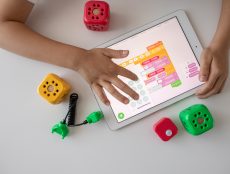
It is vital to recognize the critical role of augmented reality (AR) development in this revolutionary landscape as we observe the ongoing revolution of education brought about by emerging technologies like artificial intelligence (AI) and virtual reality (VR).
This essay explores how AI, VR, and AR may work together to revolutionize education. We specifically look at how the growth of AR is influencing education’s future, enriching classroom experiences, and providing students and teachers with new opportunities.
The Rise of AR Development
The use of augmented reality to create interactive experiences and integrate digital content into the real world has accelerated recently. The development of AR tools and applications, including their creation and use, is essential to superimposing digital data on the physical world.
The progression of AR development is transforming education by providing a wide range of augmented reality services, from mobile applications to specialized hardware. By seamlessly integrating virtual aspects into real-world situations, these services offer cutting-edge ways to engage students, encourage active learning, and improve understanding.
The potential for augmented reality services to revolutionize education and push the boundaries of conventional learning settings is enormous as they develop.
AR Applications in Education
Augmented reality (AR) in learning environments presents fascinating prospects for immersive and interactive learning. Through AR, students can interact with digital content and items in their immediate physical environment, which helps them comprehend more complex ideas.
By seeing abstract concepts, augmented reality (AR) makes them more approachable and tangible. AR development offers a dynamic educational experience, from historical recreations and science experiments to architectural simulations.
Enhancing Learning Experiences
AI, VR, and AR development can improve learning experiences. AI algorithms can examine student data, monitor development, and recommend customized recommendations.
Thanks to this individualized approach, students benefit from learning at their own pace and meeting their requirements. AR can enhance the learning experience.
Advantages of AR in Education
The development of AR has many benefits for the educational sector. Encouraging students to engage with digital content in authentic settings encourages active learning. Sharing AR experiences promotes teamwork and problem-solving abilities.
Additionally, AR can accommodate student demands and consider multiple learning styles, encouraging educational diversity. With AR, the divide between in-person and online learning is eliminated because educational resources are accessible everywhere.
Future Implications and Challenges
The future benefits of AR development in education are positive. Even more complex AR experiences targeted to specific learners will be possible thanks to technological advancements and the incorporation of AI algorithms.
However, some obstacles must be overcome, such as the requirement for teacher training to integrate augmented reality into their lesson plans successfully, access to appropriate hardware, and privacy concerns. By overcoming these obstacles, AR can develop further and improve education.
Conclusion
Recognizing the role of AR development is crucial as we examine cutting-edge technologies transforming education. The intersection of AI, VR, and AR can fundamentally alter the educational landscape.
Learning experiences are enriched, engagement is encouraged, and understanding is improved by AR’s capacity to overlay digital content in the natural environment.
By utilizing the potential of augmented reality development, educators may inspire a new generation of learners equipped with immersive and interactive learning opportunities, laying the foundation for a revolutionary and inclusive future in education.
Featured image: Thinkhubstudio, iStock.









No Comments